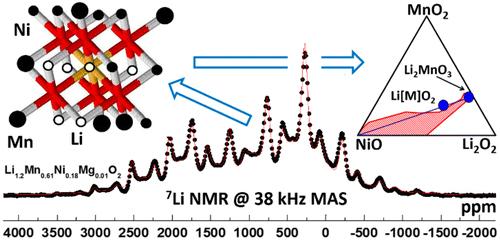The Li-rich (Mn/Ni) layered oxides combine high charge capacity, low cost, safety, and good stability in time, thus attracting a lot of attention as one promising active materials for positive electrodes in Li-ion batteries. However, during the first charge/discharge cycle, they manifest an irreversible behavior. Despite many efforts, the mechanism of Li extraction (during charge) and insertion (during discharge) and the reasons for this irreversibility are not fully clear, though the irreversibility has been linked to both non-redox (Li2O extraction) and redox (partial oxidation of oxygen).
In the present study, we combined high speed velocity (up to 60 kHz) of the rotor containing the sample and relatively low magnetic field (4.7 T) to obtain well resolved spectra (see figure recorded for the pristine material) containing in principle very detailed structural information. We thus wrote a statistical code selecting specific electroneutral cationic configurations compatible with all MAS-NMR data (peaks’ positions determined by Mn4+ and Ni2+ paramagnetic shifts, dipolar anisotropy, etc.), the technique probing the first 18 cations around a given lithium nucleus (hence the zoom-in). We showed that the pristine material was mainly segregated around two points in the (Mn/Ni/Li) phase diagram (hence the zoom-out): see figure.
We then followed
ex-situ the evolution of the NMR parameters during the first charge (five measured points) and discharge (three points) cycle (shifts’ variations, line broadening indicative of structurally perturbed domains, etc.). We also counted the lithium content as a function of voltage, the advantage over the standard electrochemical cycle being that NMR “sees” all lithium ions of the material, be they part of redox or non-redox processes. Our approach combining experiments and theory opens the way for further detailed studies aiming at both optimizing the material capacity and minimizing the size of the irreducibly damaged domains.
This international work resulted from a joint effort of both the CEA (Inac and Liten) and the Institute of Metal Physics (Ekaterinburg, Russia).
